Multi-element fingerprinting to assess chemical connectivity between prairie pothole wetlands
Researchers: Marinus Otte, Yuxiang Yuan
Researchers: Marinus Otte, Yuxiang Yuan
The question of connectivity between wetlands and Waters of the US has been particularly relevant to wetlands of the Prairie Pothole Region (PPR), because they are often referred to as ‘isolated wetlands’. It highlights our lack of understanding of how these wetlands are connected physically, chemically and ecologically, to each other and to other water bodies. Such information is critical in relation to proper protection and restoration, particularly in light of the expected effects of climate change. In this project, soils, surface water and porewater of PPR wetlands were investigated to determine chemical and hydrological connectivity of three hydrological types: recharge, flow-through, and discharge wetlands.
Publications
Yuan Y, Zhu X, Mushet DM, Otte ML (2019) Multi-element fingerprinting of waters to evaluate connectivity among depressional wetlands. Ecological Indicators 97: 398-409. https://doi.org/10.1016/j.ecolind.2018.10.033
Presentations:
- Chemical Connectivity of Prairie Pothole Wetlands – Some early results, Presented poster on current research findings at the EPA Region 8 Wetlands Conference, Boulder, CO 2017
- Chemical Connectivity of Prairie Pothole Wetlands – Some early results, Presented poster on current research findings at the SWS North Central Chapter Annual Meeting, Fargo, ND 2017
- Multi-element fingerprinting of waters to assess connectivity among prairie pothole wetlands, Presented orally on current research findings at Northern Plains Biological Symposium, Fargo, ND 2018
- Multi-element fingerprinting of waters to assess connectivity among prairie pothole wetlands, Presented orally on current research findings at SWS 2018 Annual Meeting, Denver, CO 2018
- Multi-element fingerprinting of soils to assess chemical connectivity between Prairie Pothole Wetlands, Presented orally on current research findings at SWS 2018 Annual Meeting, Denver, CO 2018
Funding Resources:
- EPA (CD-96853101)
Photos:
Nanoparticles and aquatic plants: growth and uptake
Variations in lake turbidity and phytoplankton biomass: effects of Si and Mn
Comparison of soil cadmium, uranium, and zinc between disturbed and undisturbed wetlands
Element fingerprinting of prairie pothole wetlands
Constructed wetlands for treatment of tile-drainage water and for production of biofuel
Multi-element analysis on riparian sediments
Biogeochemistry of wet ecosystems: from root zone to landscape
Multi-element fingerprinting of river sediments to identify diffuse pollution sources
Variations in fringe vegetation and turbidity of shallow lakes
Nanoparticles in crops and wetland Plants: uptake and translocation
Phyto (in) stabilization of elements
Nanoparticles and aquatic plants: growth and uptake
Researchers: La Toya Kissoon, Melissa Tracy, Hannah Passolt, Donna Jacob, and Marinus Otte
Description:
Lemna minor growth and uptake: ZnO nanoparticles in lake water and nutrient solution
Lemna minor is a free-floating plant and so receives nutrients directly from surrounding water. Previous studies have shown that Lemna can accumulate high concentrations of various metals including Cd, Cu, Cr, Ni, and Zn. Growth rates, ease of harvest, and ability to accumulate metals make Lemna an ideal candidate for use in metal uptake studies. Use of engineered nanoparticles in various products, for example, in shoes, socks, makeup, and sunscreen is increasing. The amount of these particles entering the environment and their effects on organisms is unknown, particularly in aquatic ecosystems. Few studies have considered the effects of metal nanoparticles on aquatic organisms and plants. Research has indicated that nanoparticles might disrupt cell surface or may enter cells and cause damage. Scientists have hypothesized that metal nanoparticles may be more toxic than their ionic forms, because nanoparticles may result in greater metal exposure upon entry to cells. We grew Lemna minor in pots of lake water or nutrient solution with varying concentrations of nano and non-nano ZnO to investigate effects on plant growth and uptake.
Funding sources: The project described was supported by NIH Grant Number P20 RR016471 from the INBRE Program of the National Institute of General Medical Sciences.
Watersheds and Shallow Lakes
Researchers: Steph (Longstaff) Hummel, Shane Bowe, Mark Hanson, Donna Jacob, and Marinus Otte
Description:
We are collaborating with Red Lake Reservation and the MN DNR, to investigate how watersheds are characterized by shallow lake attributes in order to better characterize shallow lakes for management purposes and predict ecological shifts that may happen with a changing climate in the future. Our study sites are located in the north western portion of MN, within the Red Lake Watershed and Clearwater Watershed.
Funding Sources: NDSU, Red Lake Department of Natural Resources
Cadmium in wetland systems
Researchers: La Toya Kissoon, Melissa Tracy, Nicholas Peterson, Donna Jacob, Marinus Otte
Description:
Aquatic plants provide a crucial link between the inorganic and abiotic environment, and influence water and sediment chemistry. Lemna minor is a free-floating plant and so receives nutrients directly from the surrounding water. Lemna minor is an important food source for a variety of ducks and geese, and is also consumed by muskrat, beaver, and fish. With increasing concentrations of metals in wetlands, aquatic plants such as Lemna minor can accumulate high amounts of metals which have the potential to be transferred to water birds. But because of this trait Lemna minor can also be used to remove large amounts of nutrients and contaminants from water. Previous studies have shown that Lemna minor can accumulate high concentrations of various metals including Cd, Cu, Cr, Ni, and Pb. The growth rates and ease of harvest of Lemna spp. make it an ideal candidate for use in phytoremediation. Soil or sediment used in treatment or mitigated wetlands contribute to element concentrations of the overlaying water.
Greenhouse experiments: We grew Lemna minor in pots of water and Cd-contaminated soil to investigate the potential for Cd to move from the soil through the water column and into plant tissues.
Field experiments: We collected and analyzed sediment, water, and aquatic plants from wetlands in northeastern North Dakota where soil Cd levels were measured at >2 mg/kg.
Presentations:
Kissoon LT, Peterson N, Jacob DL, Otte ML (2013) Potential uptake of cadmium by Lemna minor from cadmium-contaminated sediments: a mass balance approach. 10th International Phytotechnologies Conference, October 1-4, Syracuse, NY (poster).
Kissoon LT, Peterson N, Jacob DL, Otte ML (2013) Potential for cadmium uptake by Lemna minor from wetlands with cadmium-rich sediments. Society of Wetland Scientists Annual Meeting, June 2-6, Duluth, MN.
Funding sources: This research was supported by NIH grant number P20 RR016471 from the INBRE program of the National Institute of General Medical Sciences
Variations in lake turbidity and phytoplankton biomass: effects of Si and Mn
Researchers: La Toya Kissoon, Nicholas Peterson, Donna Jacob, Marinus Otte
Description: coming soon
Funding Sources: coming soon
Life-cycle approaches to understand the interactions between crops and engineered nanoparticles at the molecular level
Researchers: Donna Jacob, Marinus Otte, Dinesh Katti, Kalpana Katti, Achintya Bezbaruah
Description:
This project aims to understand interactions bewteen plants and engineered nanomaterials (ENMs) at the whole plant, cellular and molecular levels, and the roles the components of plant cells play in these interactions. This large project is collaboration bewteen researchers in the departments of Civil Engineering NDSU, and the Department of Plant Science, SDSU. Cellular interactions will be correlated with macro- and micro- level indicators in plants through molecular dynamics and steered molecular dynamics simulations. The simulations will relate to the experimental findings from the plant cell and whole plant level to molecular level changes, and then relate them to plant tissue and health. In vivo and in vitro studies will be conducted with fresh crop spinach (Spinacea oleracea) and correlated to observations from genomic studies. Rice (Oryza sativa) will be studied as a reference plant and in vivo and genomic data will be collected for comparison. Studies on molecular level interactions of plants with EMNs are limited. Plants, including food crops, are found to take up and translocate ENMs, and both positive and detrimental impacts of ENMs on plant growth and development have been observed. The possible mechanisms have not been clearly elucidated. Likewise, studies on molecular-level interactions of plants with EMNs are limited. Analysis of in vivo and in vitro experimental data are expected to fill the knowledge gap. Modeling will provide an insight into molecular level impact on DNA and plant biomolecules resulting from the proximity of nanoparticles and possibly correlate to tissue/plant health. New characterization techniques (e.g., use of AFM force curves) for ENM (ZnO nanoparticles and CNTs) present in plant systems is also expected to be developed.
Publications and Presentations:
Funding Resources:
- USDA-AFRI Foundational Program “Physical and Molecular Mechanisms of Food Contamination” program (A1331) Agriculture and Food Research Initiative (AFRI) Foundational Program
Photos:
Comparison of soil cadmium, uranium, and zinc between disturbed and undisturbed wetlands
Researchers: Hannah Passolt, Carrie Werkmeister, Marinus Otte, Donna Jacob, Larry Cihacek
Description:
Wetland ecosystems are influenced by anthropogenic activity. Metals of interest in this project are cadmium, uranium, and zinc. Disturbances can cause changes in the cycle of these metals in the soil and sediment as part of geochemical processes. Comparison of the concentrations of these metals between disturbed and undisturbed wetlands will provide information on how human disturbance effects the concentration of metals in the soil. At high exposures, these metals can have adverse effects on human health. This project aims to examine metal concentration 1) at depth, and 2) between disturbed and undisturbed wetlands .In North Dakota, six prairie pothole wetlands (three undisturbed and three disturbed, proximate to each other) will be sampled. Five core samples will be taken from each wetland. Samples will be analyzed via ICP-MS for metal concentrations. Metal concentrations will be compared 1) within each sample (concentration gradient), 2) along transects within each wetland, and 3) between similar sampling points along transects between proximate wetlands (disturbed and undisturbed). There will be a significant difference in the concentrations of these metals between disturbed and undisturbed wetlands due to anthropogenic effects. This research will provide supporting data for the restoration of wetlands, and information on the cycling and interactions of these elements as part of geo chemical processes. Outcomes will also provide new avenues into research of the interactions between microbes, plants, and soils.
Presentations:
- Passolt H, Werkmeister C, Otte M, Jacob D (2012) Comparison of soil cadmium, uranium, and zinc between disturbed and undisturbed wetlands. The 4th Biennial National IDeA Symposium, June 25 – 27, 2012, Washington, DC.
- Hannah Passolt, Carrie Werkmeister, Larry Cihacek, Marinus Otte, Donna Jacob. Variation in soil concentration of cadmium, uranium, and znc between disturbed and undisturbed wetlands. NDSU Environmental and Conservation Science recruitment fair, November 2, 2012, Fargo, ND.
- Hannah Passolt, Carrie Werkmeister, Larry Cihacek, Marinus Otte, Donna Jacob. Variation in soil concentration of cadmium, uranium, and znc between disturbed and undisturbed wetlands. Annual INBRE meeting, October 19, 2012, Grand Forks, ND.
Funding Resources:
This project was supported by grants from the National Center for Research Resources (5P20RR016471-12) and the National Institute of General Medical Sciences (8 P20 GM103442-12) from the National Institutes of Health (INBRE)
Photos:
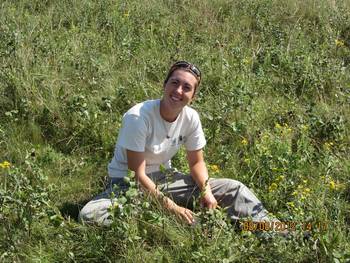
Multi-element composition of soil profiles as indicators of past and present ecosystem integrity in prairie potholes
Researchers: Carrie Werkmeister, Donna Jacob, Marinus Otte, Larry Cihacek
Description:
A historical baseline of the health of wetlands in the prairie pothole region is needed to understand the anthropogenic and natural impacts over time. The element contents of soils are influenced by: (1) the origin of the materials that formed the soils, (2) climate, (3) land use, (4) time and (5) biota. The study aims to assess if multi-element fingerprinting of vertical soils profiles of prairie pothole wetlands can be used to determine the depth of disturbance and potential for restoration. The main questions to be answered are: a) How do element concentrations vary along the vertical soil profile? b) Are there differences between good quality, relatively undisturbed wetlands, and poor quality disturbed wetlands? c) If so, how consistent are these differences? d) Can Multi-element fingerprints be used to determine the feasibility of restoration?
Publications & Presentations:
- Hannah Passolt, Carrie Werkmeister, Larry Cihacek, Marinus Otte, Donna Jacob. Variation in Soil concentration of Cadmium, Uranium, and Zinc Between Disturbed and Undisturbed Wetlands. NDSU Environmental and Conservation Science recruitment fair, November 2, 2012, Fargo, ND.
- Hannah Passolt, Carrie Werkmeister, Larry Cihacek, Marinus Otte, Donna Jacob. Variation in Soil concentration of Cadmium, Uranium, and Zinc Between Disturbed and Undisturbed Wetlands. Annual INBRE meeting, October 19, 2012, Grand Forks, ND.
- Hannah Passolt, Carrie Werkmeister, Marinus Otte, Donna Jacob. Comparison of soil Cadmium, Uranium, and Zinc between Disturbed and Undisturbed Wetlands. The 4th Biennial National IDeA Symposium, June 25 – 27, 2012, Washington, DC.
Funding Resources:
- EPA/ND Department of Health
- This project was supported by grants from the National Center for Research Resources (5P20RR016471-12) and the National Institute of General Medical Sciences (8 P20 GM103442-12) from the National Institutes of Health (INBRE).
Photos:
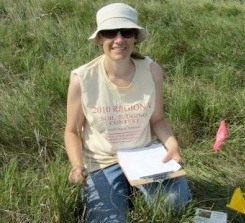 | 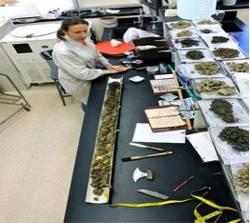 | 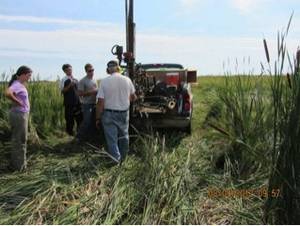 |
|---|
Element fingerprinting of prairie pothole wetlands
Researchers: Alex Yellick, Donna Jacob, Marinus Otte
Description:
In short, my research has to do with identifying a link between the chemical (multi-element) composition of wetland sediment and factors which influence its composition. My aim is to understand how factors including plant communities, plant community disturbance due to grazing, hydrological function (recharge/discharge), organic matter, pH, and particle size contribute to variability over a wide geographic extent (ND statewide). The goal of my research is to develop methods of analyzing such data as well as gain a sense of its applicability as a method of rapid evaluation of wetland condition.
Publications
Jacob DL, Yellick AH, Kissoon LT, Asgary A, Wijeyaratne DN, Saini-Eidukat B, Otte ML (2013) Cadmium and associated metals in soils and sediments of wetlands across the Northern Plains, USA. Environmental Pollution 178:211-219. dx.doi.org/10.1016/j.envpol.2013.03.005
Presentations:
- Multi-element Fingerprinting of Wetlands: A Novel Approach in Assessing Wetland Condition, Presented poster on research findings and progress at the Society of Wetland Scientists/International Association for Ecology conference in Orlando, FL 2012
- Rapid Assessment of Wetland Plant Communities in the Context of Multi-Element Fingerprinting, Presented orally on current research findings at the Northern Plains Biological Sciences Biological Symposium in Fargo, ND 2012
- Multi-element Fingerprinting of Wetlands: A Novel Approach in Assessing Wetland Condition, Presented poster my graduate studies at the Environmental and Conservation Sciences Graduate Research Poster Session in Fargo, ND 2011
- Multi-element Fingerprinting: A Key for Determining Wetland Quality Based on Soil Chemistry ,Invited to present poster on proposed dichotomous elemental key to be used in assessment of wetland quality at the EPA Region 8 Wetland Program Capacity Building Workshop in Bozeman, MT 2010
- Rapid Chemical Assessment of Wetlands, Presented orally on current research findings to the 2010 Northern Plains Biological Sciences Annual Symposium, Fargo, ND 2010
- Rapid Assessment of Prairie Potholes by Multi-element Fingerprinting, Presented poster on research objectives at the International Symposium on Wetland Biogeochemistry/Society of Wetland Scientists, Madison, WI 2009
- Rapid Assessment of our Water Resources by Multi-element Fingerprinting, Presented poster on research objectives at the Idea Network of Biomedical Research Excellence Annual Symposium, Grand Forks, ND 2009 <//span><//span><//span><//span>
Funding Resources:
- EPA/ND Department of Health Wetland Program Development Grant, National Center for Research Resources (5P20RR016471-12)
- The National Center for Research Resources (5P20RR016471-12) and the National Institute of General Medical Sciences (8 P20 GM103442-12) from the National Institutes of Health (INBRE)
- NDSU EPSCoR ?
- ND Agriculture Experiment Station/NDSU College of Science and Mathematics collaborative grant program
- Upper Midwest Aerospace Consortium/NASA (subcontract)
Photos:
Constructed wetlands for treatment of tile-drainage water and for production of biofuel
Researchers : Alex Stalboerger, Donna Jacob, Marinus Otte, Jim Barbour
Description:
Constructed a treatment wetland for the removal of sulfate from agricultural tile-drain water. This can be achieved by chemically reducing sulfate to sulfide via filtering the water through anaerobic soils high in organic matter. This chemical process of chemically reducing sulfate to sulfide displaces phosphate bound to soil particles. Phosphate can become an issue downstream by eutrophying waters and causing algal blooms which can use up all of the available oxygen and making them inhabitable for many organisms. To mitigate this we then flow the water through an aerobic environment with many fast growing wetlands species (Salix viminalis QC83 and Typha latifolia) which aerate the waters through their roots via radial oxygen loss (ROL). The higher in oxygen waters rebind the phosphate to the sediment. Thus we can remove sulfate from the tile-drained waters without causing downstream eutrophication. The Salix species is also being looked at for possible local bio-fuel applications to help generate income for potential landowners.
Presentations:
- Stalboerger (2012) Treatment wetlands for the reduction of sulfate and binding of phosphate. Northern Plains Biological Symposium, Fargo, ND, April 19, 2012.
- Stalboerger AJ, Lin W, Jacob DL, Otte ML (2012) Treatment wetlands for removal of sulfate from tile drain water. SWS/INTECOLMeeting, Orlando, FL June 2012.
- Stalboerger AJ, Lin W, Jacob DL, Otte ML (2011) Construction of a treatment wetland for sulfate removal from tile drain water and a for production of biofuel. ECS Environmental and Conservation Science Recruiting Fair, NDSU, October 5, 2011.
- Stalboerger AJ, Lin W, Jacob DL, Otte ML (2011) Construction of a treatment wetland for sulfate removal from tile drain water anda for production of biofuel. Society of Wetland Scientists North Central Chapter meeting, September 22-24, Jamestown, ND.
Funding Resources:
- USDA-CIG
- EPA 319-DOH
- NDWRRI
- This project was supported by grants from the National Center for Research Resources (5P20RR016471-12) and the National Institute of General Medical Sciences (8 P20 GM103442-12) from the National Institutes of Health (INBRE)
Photos:
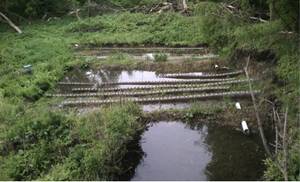 | 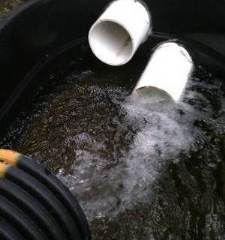 | 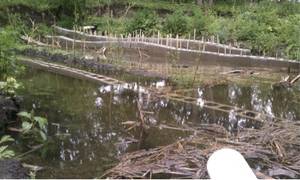 |
|---|
Multi-element fingerprinting of sediments at the Little Missouri River and at the Red River of the North to investigate the sources of uranium and cadmium
Researchers: Aude Monthean, Aida Asgary, Donna Jacob, Marinus Otte
Funding Resources:
This project was supported by grants from the National Center for Research Resources (5P20RR016471-12) and the National Institute of General Medical Sciences (8 P20 GM103442-12) from the National Institutes of Health.
Description:
Riparian wetlands are impacted by land use and geography through interactions between water and soil. The Little Missouri River and its tributaries are known to intercept uranium-rich lignite deposits, while the Red River is enriched with cadmium and other metals, presumably from the Dakota Aquifer. This study aims to identify the tributaries along the rivers that contribute most uranium to the Little Missouri sediments, and cadmium to the Red River.
During summer 2012, possible sources of uranium concentration in the Little Missouri River were located. Sediments were sampled (n=5) from 50 meters upstream and downstream of confluence of tributaries, and from 50 meters inside tributaries. And Turtle River was sampled (n=5) as a possible source for cadmium in the Red River of the North. Sediment samples were analyzed using Inductively Coupled Plasma Mass Spectrometry.
For both rivers, cadmium and uranium levels are less than 0.01 μmol.g-1. On three sampled tributaries only one is contributing to uranium levels in the Little Missouri River. As for the Red River, the Turtle River may contribute to cadmium concentrations to the river.
Sediment fingerprinting could give valuable information regarding possible sources within a catchment, and support the design and implementation of sediment control strategies.
Publications and Presentations:
Monthean A, Asgary A, Jacob DL, Otte ML (2012) Multi-element fingerprinting of sediments at Little Missouri River to inverstigate the sources of uranium. The 4th Biennial National IDeA Symposium, June 25 – 27, 2012, Washington, DC.
Photos:
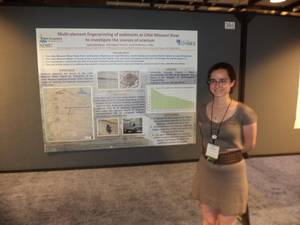
Article Links: Multi-Element Fingerprinting of Sediments at the Little Missouri River and at the Red River of the North to Investigate the Sources of Uranium and Cadmium
Multi-element analysis on riparian sediments
Researchers: Aida Asgary, Donna Jacob, Marinus Otte
Description:
Deals with study of the concentrations and distribution of elements in riparian wetlands and sediment of the Red, Sheyenne, James, Missouri and Little Missouri Rivers in North Dakota. The Project aims to evaluate the suitability of the multi-element fingerprinting method for monitoring riparian wetlands. We are hypothesizing that the results will show significant variations in element concentrations since the geology and landscape changes within the study area.
Publications:
Jacob DL, Yellick AH, Kissoon LT, Asgary A, Wijeyaratne DN, Saini-Eidukat B, Otte ML (2013) Cadmium and associated metals in soils and sediments of wetlands across the Northern Plains, USA. Environmental Pollution 178:211-219. dx.doi.org/10.1016/j.envpol.2013.03.005
Presentations:
- "Multi-element Fingerprinting of Riparian Wetlands" Presented a poster on the progress and new findings of the research INTECOL International Wetlands Conference in Orlando, FL (2012)
- "Multi-element Analysis of Riparian Sediments" Presented orally on research at the Northern Plains Biological Sciences Biological Symposium in Fargo, ND (2012)
- "Element Fingerprinting of Riparian Wetlands" Presented a poster at the Society of Wetlands Scientists Conference in James Town, ND (2011)
Funding Resources:
- EPA/ND Dept. of Health Wetland Program Development Grant, National Center for Research Resources (5P20RR016471-12)
- This project was supported by grants from the National Center for Research Resources (5P20RR016471-12) and the National Institute of General Medical Sciences (8 P20 GM103442-12) from the National Institutes of Health (INBRE)
Photos:
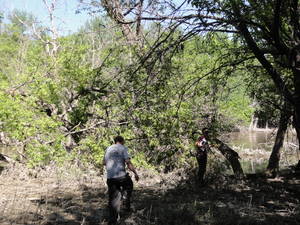 | 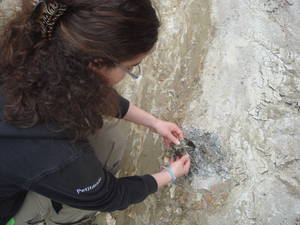 | 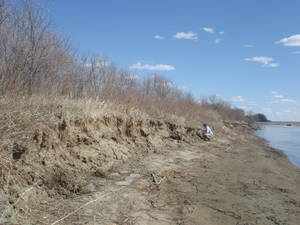 |
|---|
Article Links : Multi-element Analysis on Riparian Sediments
Cadmium contaminated soil in North Dakota and the effects of sunflowers (Helianthus annuus L.) on mobilization, uptake and immobilization
Researchers : Emily Fischbach, Marinus Otte, and Donna Jacob
Description :
Sunflowers (Helianthus annuus L.)are a common crop in North Dakota, where cadmium is naturally occurring in some areas, and this metal may be incorporated into the plant tissues. This study will examine leaching of cadmium through the soil column during rain events, mobilization, and uptake. Two varieties of H. annuus L. will be planted in two soils, one “normal soil” and one with higher cadmium concentrations. There will also be an unplanted control treatment. “Rain events” will occur twice a week using distilled water. During the three month duration of the experiment, water drained through the soil profile will be collected and analyzed for cadmium using voltammetry (Metrohm 757 VA Computrace). The leaves, roots and seeds will also be analyzed for cadmium concentrations and contents, which will yield information on uptake and distribution in the tissue. We expect to find higher concentrations of cadmium in the plants grown on the cadmium –rich soils, different concentrations between the two sunflower species, different concentrations and contents among the different plant parts, and significant effects of plant presence on cadmium mobility in the soils, but it is not known whether or not the plants will increase or decrease cadmium mobility. This research will give insight into the effects of plants on soil chemistry, and also the effect of soil chemistry on plant metal uptake.
Publications and Presentations :
- Fischbach E, Otte M, Jacob D (2011) Cadmium contaminated soil in North Dakota and the effects of sunflower (Helianthus annuus L.) on mobilization, uptake and immobilization. 2011 North Dakota INBRE Annual Symposium, October 27, Grand Forks, ND.
Funding Resources :
- This project was supported by grants from The National Center for Research Resources (5P20RR016471-12) & The National Institute of General Medical Sciences (8 P20 GM103442-12) from the National Institutes of Health.
Photos :
Biogeochemistry of wet ecosystems : from root zone to landscape
Researchers : La Toya Kissoon, Donna L. Jacob, Marinus L. Otte, Mark Hanson, Brian Herwig, Shane Bowe
Description:
The biogeochemistry of wetland ecosystems varies, causing them to act as sources, sinks, filters or transformers of nutrients and pollutants. Wetland plants play important roles in the cycling of elements in wet ecosystems. The structural and physiological adaptations that allow these plants to colonize wetland habitats as emergent or submerged species contribute to biogeochemical processes in wetland substrates. Rhizosphere (root zone) oxidation, iron and manganese oxide precipitation, acidification of the rhizosphere, root exudation, and microbial activity influence the mobility of elements in wetland substrates. Both emergent and submerged wetland plants can alter conditions in the rhizosphere that influence the mobility of elements. These plants are also capable of removing elements such as Cd, Cu, Fe, Mn, N, P and Zn from solution and accumulating them in their tissues.
Root zone studies were carried out in the greenhouse using the wetland plants Typha angustifolia (cattail) and Rumex crispus (curly dock) and in the field using Triglochin maritima (seaside arrowgrass) to determine differences in element concentrations in the root and bulk zone under different soil moisture conditions. Studies involving shallow lakes of Minnesota were carried out to determine relationships among (1) landscape variables (e.g. lake watershed size, percent agriculture, percent woodland), water and sediment characteristics (turbidity, chlorophyll-a, organic content, particle size), (3) element concentrations in waters and sediments, and (3) plant abundance and community composition.
The studies reported here showed that different factors influenced the distribution of multiple elements in the root zone of emergent wetland plants and in waters and sediment of shallow lakes. First, the root zone studies indicated that pH, redox and moisture content of wetland soils influenced the distribution of elements in the rhizosphere and subsequent uptake of these elements by wetland plants. Second, the shallow lake study showed that land cover uses (agriculture and woodland), lake watershed size, and sediment physical characteristics (organic content and particle size) influenced the distribution of the elements in waters and sediments of shallow lakes. Concentrations of these elements, land cover uses, open water area, turbidity, chlorophyll-a concentrations and sediment physical characteristics influenced abundance and distribution of submerged and floating plants.
Publications:
Jacob DL, Yellick AH, Kissoon LT, Asgary A, Wijeyaratne DN, Saini-Eidukat B, Otte ML (2013) Cadmium and associated metals in soils and sediments of wetlands across the Northern Plains, USA. Environmental Pollution 178:211-219. http://dx.doi.org/10.1016/j.envpol.2013.03.005
Kissoon LT, Jacob DL, Hanson MA, Herwig BR, Bowe SE, Otte ML (in press) Macrophytes in shallow lakes: relationships with water, sediment and watershed characteristics. Aquatic Botany.
Kissoon, L.T., Jacob, D.L. and Otte, M.L. (2011). Multiple elements in Typha angustifolia rhizosphere and plants: wetland versus dryland. Environmental and Experimental Botany, 72, 232-241.
Kissoon, L.T., Jacob, D.L. and Otte, M.L. (2010). Multi-element accumulation near Rumex crispus roots under wetland and dryland conditions. Environmental Pollution, 158, 1834-1841.
Presentations:
- Kissoon L.T., Jacob D.L., Hanson, M.A., Herwig, B.R., Bowe, S.E. and Otte, M.L. (2012). Plant communities and biogeochemistry of clear and turbid shallow lakes. 9thINTECOL International Wetlands Conference, June 3-8, 2012.
- Kissoon L.T., Jacob D.L., Hanson, M.A., Herwig, B.R., Bowe, S.E. and Otte, M.L. (2011). Shallow lakes: ecology and biogeochemistry. 1stAnnual Meeting of the North Central Chapter –Society of Wetland Scientists, September 22-24, 2011.
- Sullivan, R.D., Fischbach, E.K., Kissoon, L.T., Jacob, D.L., Hanson, M.A. and Otte, M.L. (2011). Relationship between fringe vegetation composition and shallow lake turbidity? 1stAnnual Meeting of the North Central Chapter –Society of Wetland Scientists, September 22-24, 2011.
- Kissoon, L.T., Jacob, D.L., Hanson, M.A., Herwig, B.R., Bowe, S.E. and Otte, M.L. (2011). Shallow lake ecology: biogeochemistry and plant community composition. 8th Annual Northern Plains Biological Symposium, April 6-8, 2011.
- Kissoon, L.T., Jacob, D.L., Hanson, M.A., Herwig, B.R., Bowe, S.E. and Otte, M.L. (2010). Variation in aquatic plant communities in shallow lakes: relationship with biogeochemistry? ND/SD EPSCoR 9thBiennial Conference, September 29, 2010.
- Kissoon, L.T., Jacob, D.L. and Otte, M.L. (2010). Accumulation of Cu, Fe and Zn in the root zone and plant material of Typha angustifolia. 7thAnnual Northern Plains Biological Symposium, April 8, 2010.
- Kissoon, L.T., Jacob, D.L. and Otte, M.L. (2009). Typha angustifoliaroots are exposed to higher metal concentrations under wetland compared with dryland conditions. The Society of Wetland Scientists –2009 Society of Wetland Scientists-Wisconsin Wetlands Association-Wetland Biogeochemistry Symposium, June 25, 2009.
- Kissoon, L.T., Jacob, D.L. and Otte, M.L. (2008). Distribution of metals in the rhizosphere in response to flooding. ND/SD EPSCoR 7thBiennial Conference, September 19, 2008.
- Kissoon, L.T., Jacob, D.L. and Otte, M.L. (2008). The distribution of metals in the soil below wetland plants under flooded and non-flooded conditions. The Society of Wetland Scientists –Capitalizing on Wetlands, Annual International Conference, May 29, 2008.
- Kissoon, L.T., Jacob, D.L. and Otte, M.L. (2008). Biogeochemical changes in the rhizosphere of Rumex crispusand Typha angustifoliagrown in flooded and non-flooded soil: Implications for metal tolerance in wetland plants. 5thAnnual Northern Plains Biological Symposium, April 11, 2008.
Funding Resources:
- This project was supported by ND ESPCoR and NSF (grant # EPS-0814442)
- Minnesota Department of Natural Resources
- Red Lake Department of Natural Resources
- The Wetland Foundation
- Sigma Xi Grants-in-Aid of Research
- Grants from the National Center for Research Resources (5P20RR016471-12) and the National Institute of General Medical Sciences (8 P20 GM103442-12) from the National Institutes of Health, INBRE
Photos:
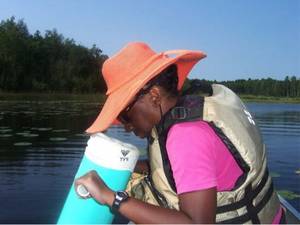 | 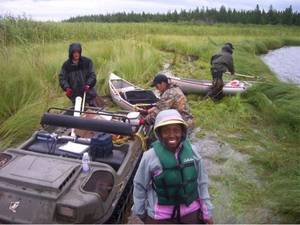 | 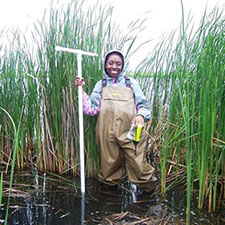 |
|---|
Article Links: Biogeochemistry of wet ecosystems : from root zone to land scape
Multi-element fingerprinting of river sediments to identify diffuse pollution sources
Researchers: Dimuthu Wijeyaratne, Donna Jacob, Marinus Otte
Description:
This study was carried out in the Souris and Turtle Rivers in North Dakota. The aim of this study was to develop multi-element fingerprints of the Souris River and Turtle River sediments and to evaluate the suitability of these fingerprints to assess the geographic origin of potential pollutants of the two rivers. Preliminary analysis of Souris River sediment samples confirmed that the multi-element fingerprinting can be used to assess the sediment and contaminant loading patterns. Laboratory experiments were performed to assess the validity of linear mixing assumption in multi-element fingerprinting studies. The results of these experiments verified the assumptions and showed that there is a statistically significant spatial and temporal variation in the element concentrations depending on their mobility and re-deposition.
Field studies were conducted in the Souris River and Turtle River to assess the variation of element concentrations in the top riverbed samples along the main rivers and their tributaries. The sediment contribution from the tributaries and the phosphorus concentrations in the main channel were used to calculate the phosphorus contributions from the tributary sediments to the Souris River. The differences in phosphorus contributions from tributaries were related to land use, underlying geology, and the size of the watersheds of the tributaries in the Souris River watershed. Similar analysis was used in the Turtle River to calculate arsenic, cadmium and selenium contribution from the tributaries to the Turtle River. The differences in the contribution of these elements were related to the underlying geology and the size of the watersheds.
This study provides a detailed analysis of element concentrations and relative sediments and element loading rates from the tributaries to the main rivers along the Souris and Turtle Rivers in North Dakota. The multi-element fingerprinting technique can be successfully used as a tool to identify the relative contribution of sediments and assessing and tracing pollution sources in rivers. Multi-element fingerprinting provides a relatively low cost, rapid tool for sediment tracking, without the need for addition of exotic chemicals such radio-tracers or dyes to natural ecosystems.
Publication
Jacob DL, Yellick AH, Kissoon LT, Asgary A, Wijeyaratne DN, Saini-Eidukat B, Otte ML (2013) Cadmium and associated metals in soils and sediments of wetlands across the Northern Plains, USA. Environmental Pollution 178:211-219. dx.doi.org/10.1016/j.envpol.2013.03.005
Presentations:
- Wijeyaratne D, Jacob DL, Otte ML (2010) Chemical fingerprinting and determination of tributary contribution of trace elements in the Souris River, ND. 2010 Eastern South Dakota Water Conference, November 9-10, 2010, Brookings, SD.
- Wijeyaratne D, Jacob DL, Otte, ML (2010) A multi-element fingerprinting approach to assess phosphorus contamination in the Souris River sediments. ECS Greenbag Seminar Series, October 12, 2010, NDSU.
- Wijeyaratne D, Jacob DL, Otte ML (2010) Chemical fingerprinting and determination of tributary contribution of trace elements in the upper Souris River, ND. 7th Annual Northern Plains Biological Symposium, April 8, 2010, Fargo, ND.
Funding Resources:
- This project was supported by grants from the National Center for Research Resources (5P20RR016471-12) and the National Institute of General Medical Sciences (8 P20 GM103442-12) from the National Institutes of Health (INBRE).
- North Dakota Water Resources Research Institute Graduate Fellowship
- North Dakota Water Resources Research Institute supplementary funding
- North Dakota State Water Commission
- North Dakota Department of Health
- The Graduate School of NDSU
- NDSU Department of Biological Sciences
- NDSU Environmental Conservation Sciences Graduate Program
- NDSU College of Science and Mathematics
Photos:
Variation in multi-element uptake in Quercus macrocarpa (Bur Oak) between sites in the Red River flood plain over 130 years
Researchers: Justin Tabaka, Donna Jacob, Joseph Zeleznik
Description:
Trees may provide a long-term record of metals in their environment over decades and centuries. By comparing the accumulation of elements in xylem tissue over time it may be possible to assess metal exposure in the environment. Element accumulation patterns in trees from different sites may reflect local environmental conditions or anthropogenic sources of metals. Xylem samples from the years 1876 through 2010, in 20-year segments, were collected from Quercus macrocarpa trees originating from differing sites near the Red River of the North; a natural flood plain and a managed golf course. The samples were microwave digested in nitric acid and analyzed with ICP-OES for 33 elements. For this project, the results showed some significant differences between sites for corresponding years, and varying accumulation patterns over time. Dendrochemical analysis has the potential to be a method for monitoring environmental variation and metal accumulation in ecosystems.
Presentations:
Tabaka JW, Zeleznik J, Otte ML, Jacob DL (2011) Dendrochemical analysis of Quercus macrocarpa. Central Region IDeA Conference, May 23-25, Omaha, NE.
Funding Resources:
This project was supported by grants from the National Center for Research Resources (5P20RR016471-12) and the National Institute of General Medical Sciences (8 P20 GM103442-12) from the National Institutes of Health (INBRE)
Photos:
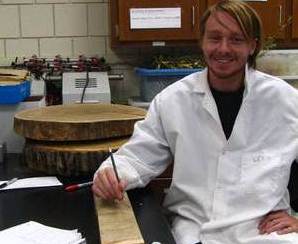 | 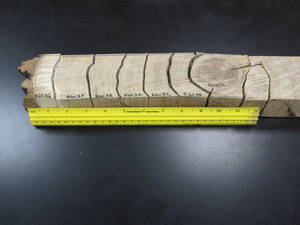 |
|---|
Variations in fringe vegetation and turbidity of shallow lakes
- Researchers : Ryan D. Sullivan1, Emily Fischbach1, La Toya Kissoon1, Donna Jacob1, Mark Hanson2, and Marinus Otte1
1Wet Ecosystem Research Group, Department of Biological Sciences, North Dakota State University, Fargo, ND
2Wetland Wildlife Population and Research Group, Minnesota DNR, Bemidji, MN
Description:
The management of algal blooms is a high priority due to their increasing occurrence and extent in surface waters and their adverse effects on ecosystems. The decomposition of barley straw is reported to effectively inhibit the reproduction of certain algal species. Similar to barley straw, emergent vegetation on the fringe of shallow lakes may play a role in lake turbidity by inhibiting algal reproduction through regular contributions of organic matter. Water turbidity and percent composition of dominant fringe species were determined for 21 lakes near Windom, MN to determine relationships between the two variables. Shallow lake fringe dominated by Typha spp. correlated negatively with water turbidity while fringe dominated by trees or Phalaris arundinacea correlated positively with turbidity. Considerations of human labor and ecological impacts associated with the introduction of Typha spp. as well as further research needs on the subject are discussed.
Presentations:
- Sullivan R, Fischbach E, Kissoon LT, Jacob DJ, Hanson M, Otte M (2011) Relationship between fringe vegetation composition and shallow lake turbidity? Environmental and Conservation Science Recruiting Fair, NDSU, October 5, 2011.
- Sullivan R, Fischbach E, Kissoon LT, Jacob DJ, Hanson M, Otte M (2011) Relationship between fringe vegetation composition and shallow lake turbidity? Society of Wetland Scientists North Central Chapter meeting, September 22-24, Jamestown, ND.
Funding Resources:
- Minnesota Department of Natural Resources
- This project was supported by grants from the National Center for Research Resources (5P20RR016471-12) and the National Institute of General Medical Sciences (8 P20 GM103442-12) from the National Institutes of Health (INBRE)
Photos:
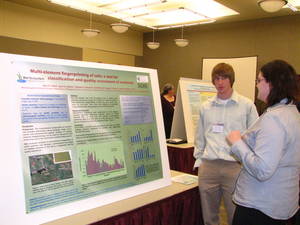
Nanoparticles in crops and wetland Plants: uptake and translocation
Researchers: Donna L. Jacob1, Joshua D. Borchardt1, Leelaruban Navaratnam2, Marinus L. Otte1, and Achintya N. Bezbaruah2
1Wet Ecosystem Research Group, Department of Biological Sciences, North Dakota, State University, Fargo, North Dakota, USA
2Nanoenvirology Research Group, Department of Civil Engineering, North Dakota State University, Fargo, North Dakota, USA
Description:
Bioavailability of engineered metal nanoparticles affects uptake in plants, impacts on ecosystems, and phytoremediation. We studied uptake and translocation of Ti in plants when the main source of this metal was TiO2 nanoparticles. Two crops (Phaseolus vulgaris (bean) and Triticum aestivum (wheat)), a wetland species (Rumex crispus, curly dock), and the floating aquatic plant (Elodea canadensis, Canadian waterweed), were grown in nutrient solutions with TiO2 nanoparticles (0, 6, 18 mmol Ti L−1 for P. vulgaris, T. aestivum, and R. crispus; and 0 and 12 mmol Ti L−1 for E. canadensis). Also examined in E. canadensis was the influence of TiO2 nanoparticles upon the uptake of Fe, Mn, and Mg, and the influence of P on Ti uptake. For the rooted plants, exposure to TiO2 nanoparticles did not affect biomass production, but significantly increased root Ti sorption and uptake. R. crispus showed translocation of Ti into the shoots. E. canadensis also showed significant uptake of Ti, P in the nutrient solution significantly decreased Ti uptake, and the uptake patterns of Mn and Mg were altered. Ti from nano-Ti was bioavailable to plants, thus showing the potential for cycling in ecosystems and for phytoremediation, particularly where water is the main carrier.
Publications:
- Jacob DJ, Borchardt JD, Navaratnam L, Otte ML, Bezbaruah AN (2013) Uptake and translocation of Ti from nanoparticles in crops and wetland plants, International Journal of Phytoremediation. 15:142-153.
Funding Resources:
- NDSU Environmental and Conservation Sciences Program Collaborative Research Proposals
- This project was supported by grants from the National Center for Research Resources (5P20RR016471-12) and the National Institute of General Medical Sciences (8 P20 GM103442-12) from the National Institutes of Health (INBRE)
- The North Dakota State University Environmental and Conservation Science Graduate Program
- Department of Biological Sciences Frank Cassel Undergraduate Research Awards program (Borchardt)
Photos:
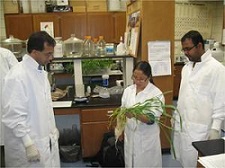
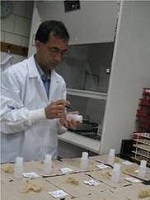
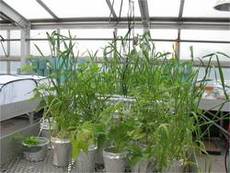
Do titanium oxide engineered nanoparticles affect elemental composition of the aquatic plant Elodea canadensis?
Researchers: Josh Borchardt, Donna Jacob, Marinus Otte
Description:
Nanoparticle use is increasing around the world and is quickly becoming a multi-billion dollar a year industry. TiO2 nanoparticles are found in a wide variety of products such as sunscreens, toothpastes, and paints, and are likely to wash into wetland ecosystems because of their association with drains or swimmers. The objective of this project was to investigate the effect of titanium engineered nanoparticles and different concentrations of phosphorus (0, 5, 10, and 20 mg L-1) on uptake of metals in a common aquatic plant, Elodea canadensis. I used a fully-randomized block design with a modified Long-Ashton hydroponic nutrient solution. After two weeks, the plant samples were analyzed via ICP-OES for elemental concentrations of Mg, Mn, P, Ti, and Fe. Statistics were run with Minitab and a two-way ANOVA. I found that titanium engineered nanoparticles and phosphorus do have an effect on uptake concentrations of other elements. These results contribute to our knowledge of the potential consequences of nanoparticle release into aquatic environments.
Publications:
- Jacob DJ, Borchardt JD, Navaratnam L, Otte ML, Bezbaruah AN (2013) Uptake and translocation of Ti from nanoparticles in crops and wetland plants, International Journal of Phytoremediation. 15:142-153.
Presentations:
- Borchardt J, Jacob DL, Otte ML (2010) Do titanium oxide nanoparticles affect elementan composition of the aquatic plant Elodea canadensis? 7th Annual Northern Plains Biological Symposium, April 8, 2010, Fargo, ND.
- Borchardt J, Jacob DL, Otte ML (2009) TiO2 nanoparticle uptake in Elodea canadensis. 2009 North Dakota INBRE Annual Meeting, Oct 22, 2009, Grand Forks, ND.
- Borchardt J, Jacob DL, Otte ML (2009) TiO2 nanoparticle uptake in Elodea canadensis. 2009 Joint meeting of the Society of Wetland Scientists, Wisconsin Wetlands Association and the Wetland Biogeochemistry Symposium, June 21-26, 2009, Madison, Wisconsin.
Funding Resources:
- Robert Noyce STEM Intern Program
- NDSU Environmental and Conservation Science Graduate Program
- NDSU Department of Biological Sciences Frank Cassel Undergraduate Research Awards program
- This project was supported by grants from the National Center for Research Resources (5P20RR016471-12) and the National Institute of General Medical Sciences (8 P20 GM103442-12) from the National Institutes of Health (INBRE)
Photos:
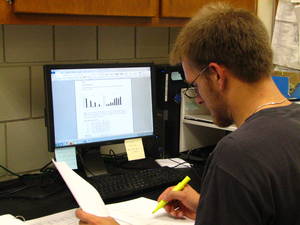 | 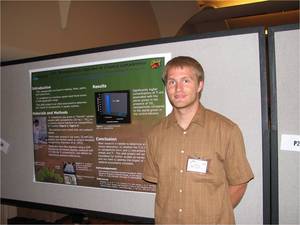 | 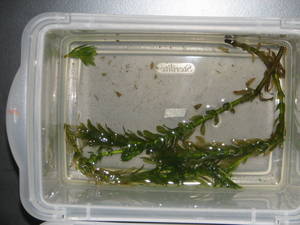 |
|---|
Multi-element composition of Triglochin maritima L. from contrasting habitats including hot springs and metal enriched areas
Researchers: Sharmila Sunwar, Donna L. Jacob, Marinus L. Otte
Description:
The aim of this PhD research was to study multi-element composition in wetland plants from contrasting habitats, including hot springs, temporary wetlands, and metal-rich areas. Triglochin maritima L. (seaside arrowgrass) was chosen for the study because this species is common on alkaline/saline soils around the world. Eleocharis rostellata, Juncus balticus, Salix exigua, S. boothii, and S. wolfii were also included in the study. Field studies and greenhouse experiments were conducted. Soil and plant samples from the field were analyzed for 32 -50 elements using inductively coupled plasma OES/MS spectrometry, while the effects of temperature and soil biota were studied in a greenhouse. Habitat specific element concentration patterns in T. maritima were observed. High Mn, Li, and B concentrations were typical of plants from hot springs, whereas Ca, P, Mg, Fe, Sr, Ba, Ti, and Cu were higher in plants from temporary wetlands. J. balticus and Salix species from mining-impacted and uncontaminated sites revealed distinct differences in multi-element concentrations. J. balticus showed high concentrations of S, K, Mn, Fe, Cu, Al, As, and Cd at contaminated sites compared to uncontaminated sites. Element concentrations of Salix species showed that S. boothii had higher concentrations of Mn, Fe, Al, and Ti compared to S. exigua and S. wolfii from the same site. To our knowledge, the association of mycorrhizal fungus in T. maritima was confirmed for the first time. Temperature affected element concentrations, contents, and translocation within plants. Generally, the contents of P, Na, Mn, B, Cu, Mo, Li, Sr, Ti, and Cs were lower at 40 °C in both roots and leaves compared to 20 and 30 °C, but their translocation from roots to leaves was higher at 40°C.
Even though the biological and physiological funtions of Li, Sr, Ba, Rb, and Ti, in plants are not fully understood, these elements were substantially taken up by T. maritima.
Publications and Presentations:
- Sunwar, Jacob, Otte (2010) Multi-element content of plants from contrasting environments in the Greater Yellowstone area. Poster for the 10th Biennial Scientific Conference of the Greater Yellowstone Ecosystem, Questioning Greater Yellowstone's Future: Climate, Land Use, and Invasive Species, October 11-13, 2010, Yellowstone National Park, WY.
- Sunwar S, Jacob DL, Otte ML (2009) Multi-element uptake: effect of temperature and salinity on Triglochin maritima populations. 2009 ND EPSCoR Annual Meeting, Sept 24, 2009, Fargo, ND.
- Sunwar S, Jacob DL, Otte ML (2009) Multi-element uptake: effect of temperature and salinity on Triglochin maritima populations. 2009 Joint meeting of the Society of Wetland Scientists, Wisconsin Wetlands Association and the Wetland Biogeochemistry Symposium, June 21-26, 2009, Madison, Wisconsin.
Funding Resources:
- This project was supported by INBRE: the National Center for Research Resources (5P20RR016471-12) and the National Institute of General Medical Sciences (8 P20 GM103442-12) from the National Institutes of Health.
- The Robert H. Levis II Cross Ranch Fellowship
- NDSU Environmental Conservation Sciences Graduate Program
- NSF/EPSCoR
Photos:
Phyto (in) stabilization of elements
Researchers : Donna L. Jacob1, Marinus L. Otte1, and David G. Hopkins2
Undergraduate Assistants : Jordan Wein, Matthew Green
1Wet Ecosystem Research Group, Department of Biological Sciences, North Dakota State University, Fargo, North Dakota, USA
2Soil Science, North Dakota State University, Fargo, North Dakota, USA
Description:
The effects of plants (corn, soybean, and sunflower) and fertilizer on mobility of more than 60 elements were assessed in a greenhouse experiment. Unplanted columns with the same soil served as controls. Half the columns received fertilizer and all columns were watered at the same rate. At the end of the experiment, the columns were watered to mimic a rainstorm event such that water drained from the bases of the columns, which was collected and analyzed for element content. Soil from between the roots of the plants was also collected and the water-extractable fraction determined. It was expected that (1) more mobile elements, as measured by water extraction, would be leached from the soils at a higher rate compared to less mobile elements, (2) plants would immobilize most elements, but that some would be immobilized, and (3) that this would depend on plant species. The results led to the following conclusions: plants cause metal mobility to vary over a wide range for a specific soil and do mobilize some elements (e.g., Th) while immobilizing others (e.g., U). The effects depended on plant species for some elements. Water-extractable fractions of elements do not predict mobility.
Publications:
- Jacob DL, Hopkins DG, Otte ML (2011) Phyto(in)stabilization of elements. International Journal of Phytoremediation 13(SI):34-54.
- Otte M.L., Hopkins D. and Jacob D.L. (2009). Plants immobilize some elements, while mobilizing others: consequences for phytostabilization. In Schwitzguebel J.P., Gupta S., Schulin R. and Demaria P. (Eds). Abstracts of the Final International Conference on Phytotechnologies to promote sustainable land use and improve food safety. Centro Stefano Franscini, Monte Verita, Ascona, Switzerland, 11-16 October, 2009. Pp. 69-70.
- Otte M.L., Hopkins D. & Jacob D.L. (2009). (Im)mobilization of multiple elements by plants. In: Burken J.G., Newman L.A., White J.C., Zeeb B.A., Nichols E.G., Zhao D. & Rock S. (Eds.). Abstracts of the 6th International Conference on Phytotechnologies, Dec 2-4, 2009, St. Louis, International Phytotechnology Society. pp. 90.
Presentations:
- Otte M.L., Hopkins D. and Jacob D.L. (2009). Plants immobilize some elements, while mobilizing others: consequences for phytostabilization. In Schwitzguebel J.P., Gupta S., Schulin R. and Demaria P. (Eds). Abstracts of the Final International Conference on Phytotechnologies to promote sustainable land use and improve food safety. Centro Stefano Franscini, Monte Verita, Ascona, Switzerland, 11-16 October, 2009. Pp. 69-70.
- Otte M.L., Hopkins D. & Jacob D.L. (2009). (Im)mobilization of multiple elements by plants. In: Burken J.G., Newman L.A., White J.C., Zeeb B.A., Nichols E.G., Zhao D. & Rock S. (Eds.). Abstracts of the 6th International Conference on Phytotechnologies, Dec 2-4, 2009, St. Louis, International Phytotechnology Society. pp. 90.
Funding Resources:
- ND Agriculture Experiment Station/NDSU College of Science and Mathematics collaborative grant program
- This project was supported by grants from the National Center for Research Resources (5P20RR016471-12) and the National Institute of General Medical Sciences (8 P20 GM103442-12) from the National Institutes of Health (INBRE)
All images are copyright of WERG.